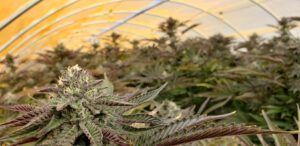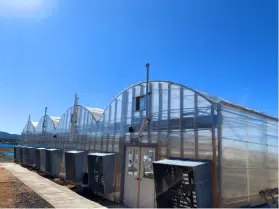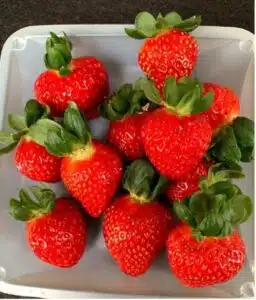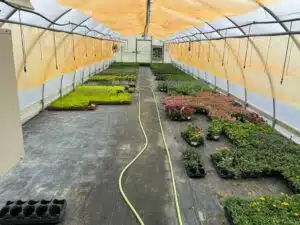
>20% Light Use Efficiency Exhibited in Tomato Trial
- Vegetables
- Case Studies
AT A GLANCE
- Results
- Crop
- Farm
- Location
Plants under the quantum dot film experienced a 14% reduction in overall daily light integral, resulting from perpendicular photosynthetically active radiation transmission of 85.3%, mainly due to reflection losses. Despite this reduction in intensity, the modified sunlight spectrum and light diffusion provided by the quantum dot film gave rise to 5.7% improved saleable production yield, nearly identical total fruiting biomass production, 23% higher light use efficiency (g/mol), 10% faster vegetative growth rate, and 36% reduced tomato waste compared to the control, which had no additional films. Based on this result, materials incorporating quantum dots show promise in enabling passive, electricity-free spectrum modification for improving crop production in greenhouse cultivation, but extensive controlled crop studies are needed to further validate their effectiveness.
The tomato cultivar chosen for the study was a beefsteak variety (Solanum lycopersicum L., Merlice)
Conducted in glass greenhouses located at the Delphy Improvement Centre in Bleiswijk, Netherlands.
Bleiswijk, Netherlands
ABOUT THE PROJECT
The spectral quality of sunlight reaching plants remains a path for optimization in greenhouse cultivation. Quantum dots represent a novel, emission-tunable luminescent material for optimizing the sunlight spectrum in greenhouses with minimal intensity loss, ultimately enabling improved light use efficiency of plant growth without requiring electricity. In this study, greenhouse films containing CuInS2/ZnS quantum dots were utilized to absorb and convert ultraviolet and blue photons from sunlight to a photoluminescent emission centered at 600 nm. To analyze the effects of the quantum dot film spectrum on plant production, a 25-week tomato trial was conducted in Dutch glass greenhouses. Improving tomato yields and overall efficiency in tomato plant cultivation were key focuses. Plants under the quantum dot film experienced a 14% reduction in overall daily light integral, resulting from perpendicular photosynthetically active radiation transmission of 85.3%, mainly due to reflection losses. Despite this reduction in intensity, the modified sunlight spectrum and light diffusion provided by the quantum dot film gave rise to 5.7% improved saleable production yield, nearly identical total fruiting biomass production, 23% higher light use efficiency (g/mol), 10% faster vegetative growth rate, and 36% reduced tomato waste compared to the control, which had no additional films. Based on this result, materials incorporating quantum dots show promise in enabling passive, electricity-free spectrum modification for improving crop production in greenhouse cultivation, but extensive controlled crop studies are needed to further validate their effectiveness.
Greenhouses offer an opportunity to control the growing environment for crops, allowing for reliable harvests and extended growing seasons, while utilizing the energy of the Sun and increasing water use efficiency by over 90% compared to field agriculture
– Nederhoff and Stanghellini, 2010
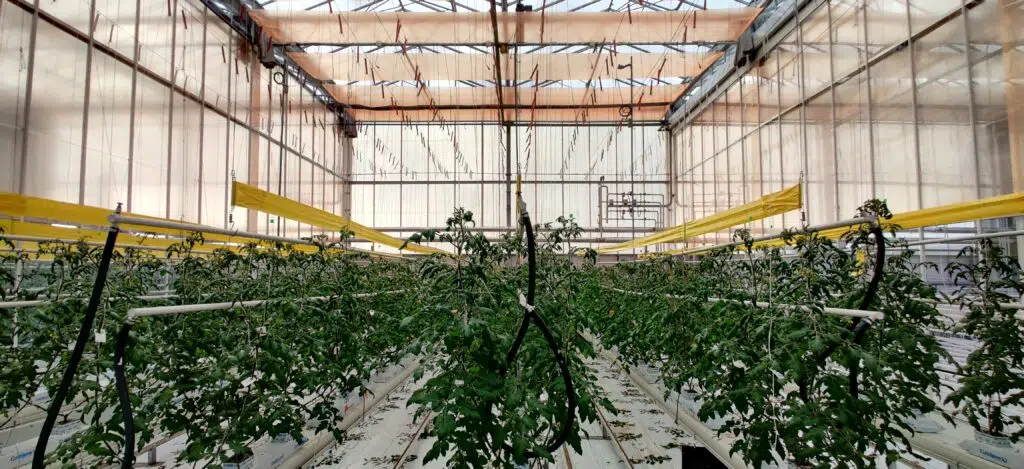
Quantum dots (QDs) represent suitable inorganic luminescent materials for optimizing the spectrum in greenhouses because they strongly absorb UV light, which is not used for photosynthesis, and a portion of blue light, and emit light towards longer wavelengths that is more photosynthetically efficient for plants. Quantum dots have optimal optical properties due to their high photoluminescence (PL) quantum yield (QY), size-tunable optical properties realized in manufacturing, and inherent photostability compared to organic dyes. Owing to their small size (<10 nm), the absorption profile and peak PL emission of QDs can be tuned during manufacturing by simply changing the size of the nanoparticles.
The modified sunlight spectrum and light diffusion provided by the quantum dot film gave rise to 5.7% improved saleable production yield, nearly identical total fruiting biomass production, 23% higher light use efficiency (g/mol), 10% faster vegetative growth rate, and 36% reduced tomato waste compared to the control, which had no additional films.
25-Week Tomato Trial
Saleable Production Yield
Relative Change: +5.7%
Fruit Biomass Production
Results: nearly identical
Light Use efficiency (g/mol)
Relative Change: +23%
Vegetable Growth Rate
Relative Change: +10% Faster
Tomato Waste
Relative Change: -36%
Results
The objectives of this study are to evaluate the effects of an altered sunlight environment resulting from the application of a retrofit QD film on the growth and fruit production of greenhouse-grown tomato plants. The hypothesis is that a red-shifted spectrum and increased light diffusion compared to a control greenhouse compartment will overcome a reduction in light intensity to result in higher fruit production and increased vegetative growth metrics, thereby improving tomato yields and light use efficiency.
Throughout the experiment, vegetative growth metrics were monitored by selecting two rows with eight tomato stems in each compartment and the following parameters were measured weekly: vine length, head thickness, number of set trusses, number of flowering trusses, number of fruits set, leaf length, number of leaves, flowering speed, and ripening time. On average, plants under the QD film grew 2.1 cm/week faster than control plants, corresponding to a +9.7% increase in vine growth. The average weekly leaf length showed a 3.8-cm increase under the QD film, a +9.5% increase. Other growth metrics showed negligible differences between the plants grown in the test and control compartments. A t-test on two samples assuming unequal variances was performed on vegetative growth metrics using each measurement week for n = 23, resulting in a p-values (two tails). p-values < 0.05 indicate that the difference in the measured metric was significant over the variance in the dataset. The data show statistical significance for both vine growth and leaf length, but no statistical significance for the other metrics, although production of one additional leaf per plant on average, over the duration of the trial, was relatively close to significant. While internodal spacing was not measured in this study, the observed increase in leaf number, leaf length, and vine length indicates more vigorous growth under the QD film. Flowering speed and fruit set data for the trial can be found in the supplemental information within the trial document.
Despite a 14% reduction in overall DLI under the QD film, this altered spectral and diffuse light environment employed over tomato plants gave rise to a +10% faster vegetative growth rate (vine stem and leaf length) and -36% reduced fruit waste, resulting in an overall +5.7% improved saleable production yield per unit area. With a +4.4% increase in Far-Red light content under the QD film, the increase in vine stem elongation and leaf length are not surprising, especially when accompanied by a reduced DLI. This study highlights the benefits of tomato plant cultivation with enhanced light use efficiency for better yields.
Plant Trial Study Details
Trial Length: 25-week plant trial
Tomato Cultivator: beefsteak variety ‘Merlice’
Quantum Dot Film 1.25 m wide, 350 µm thick
Increased Far-Red Light Content: +4.4%
Saleable Production Yield per unit area: +5.7%
Share:
Connect With Us
Company
Resources


Hunter McDaniel, PhD
Founder & CEO
Hunter earned a Ph.D. in Materials Science and Engineering at the University of Illinois at Urbana-Champaign, before joining Los Alamos National Laboratory in the Chemistry Division. Ultimately the value proposition of UbiGro is about boosting crop yields and quality without the cost or energy impact of lighting. Hunter has more than fifty publications and patents, and more than 2000 total citations, h-index: 20. Hunter fundamentally believes that novel materials underpin every significant technology advancement, and he is focused on leveraging new materials to have a lasting and sustainable impact.

Damon Hebert, PhD
Director of Agriculture
Damon brings a wide range of experience in agriculture, materials science, spectroscopy, and small business. During his time in Prof. Angus Rockett’s research group at The University of Illinois at Urbana-Champaign (UIUC), Hebert authored a doctoral thesis and multiple papers on the materials science of CIGS semiconductor materials, which is closely related to the materials developed at UbiQD. He also served as a consultant to Nanosolar, a CIGS nanocrystal solar cell manufacturing company. Hebert has industry experience having co-founded Dr. Jolly’s, a leading cultivation and distribution operation in Bend, OR.

Tania Lafaille
Sales Representative
Tania is a UbiGro Sales Representative, with over 7 years of experience in product sales (specifically berries and avocados) covering all of North America and parts of South America. While in agriculture, Tania has cultivated strong relationships with growers and distributors, granting her a unique insight into both perspectives. That understanding, paired with her fierce dedication to results, drives her fun and fiery commitment to her craft. Tania is based in Gilroy, CA.

Tyler Veyna
Sales Representative
Tyler brings 15 years of experience in Greenhouse production and facility management of a wide range of crops in multiple states to the UbiGro team. Based in Salinas, California. “Being a fourth-generation farmer, I look to improve and empower the grower, and with UbiGro, we can do just that.”

Jim Gideon
Sales Manager
Jim Gideon is an UbiGro Sales Manager, with over 25 years of greenhouse industry sales experience covering all of North America. Previously Jim has worked for Green Tek, Plazit-Polygal, Texel, Cherry Creek, and Nexus. He is based in Montgomery, AL, and Jim believes that “light is everything to the grower.”

Eric Moody
Director of Sales
Eric Moody is UbiQD’s Director of UbiGro Sales. Eric has more than 6 years of experience in horticulture lighting industry, building relationships with greenhouse growers of all sizes and crops on optimal lighting for their growing operation, and most recently managed a North American sales team for PL Light Systems. Overall, Eric has been in sales leadership positions for more than 13 years. Eric brings with him a great understanding of the market and available technologies for growers, greenhouse facilities, and sales leadership. Reach Eric by phone at 541-490-6421 or by email at [email protected].

Mike Burrows, PhD
Dr. Michael Burrows is UbiQd’s Vice President of Business Development. His educational background includes a Materials Science doctorate from the University of Delaware and an MBA from Duke University Fuqua School of Business. His career has specialized in the commercialization of novel electronic materials in venture-run programs for different industries including solar, biosensors, and the automotive industry. In both start-up and corporate environments, he has extensive experience in global market development, foraging supply chain partnerships, productization, and brand building. He is currently leading UbiQD’s partnership efforts in luminescent greenhouse technology, smart windows, and security ventures.

Matt Bergern, PhD
Cheif Product Officer
As Chief Product Officer at UbiQD, Dr. Matt Bergren leads the company’s product development efforts, sales, and product manufacturing, including the company’s first commercial agriculture product, UbiGro. He plays a critical role in continuing the company’s path of technology development and vision of powering product innovations in agriculture, clean energy, and security.
He serves as the principal investigator for UbiQD’s contract with NASA, focused on tailoring the solar spectrum for enhanced crop production for space missions. Dr. Bergren’s leadership experience includes serving on the board of directors for the New Mexico Energy Manufacturing Institute, focused on job creation in New Mexico’s energy, and related manufacturing community.
